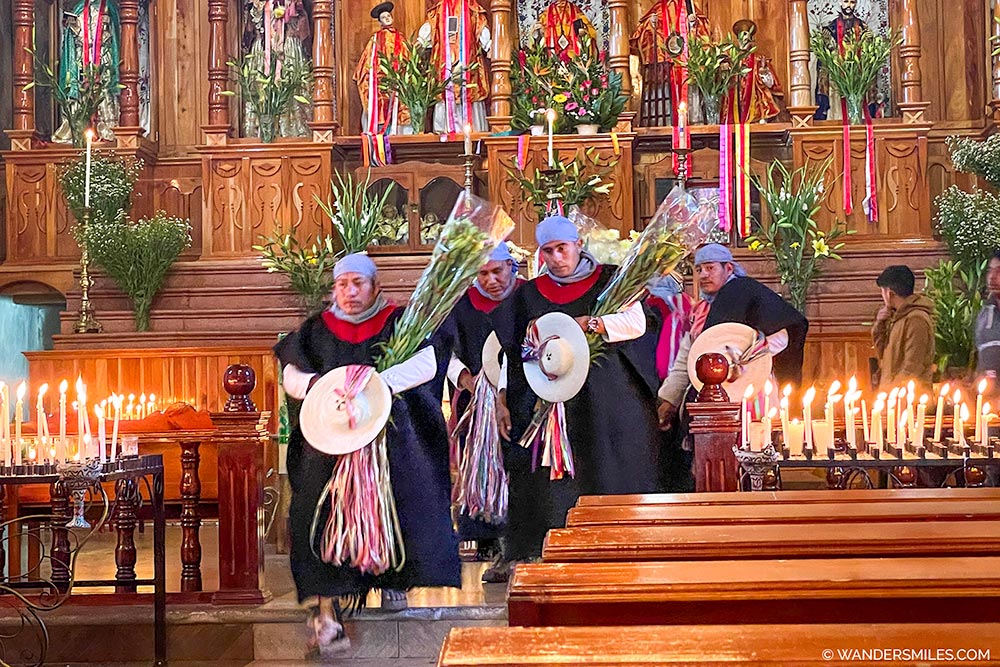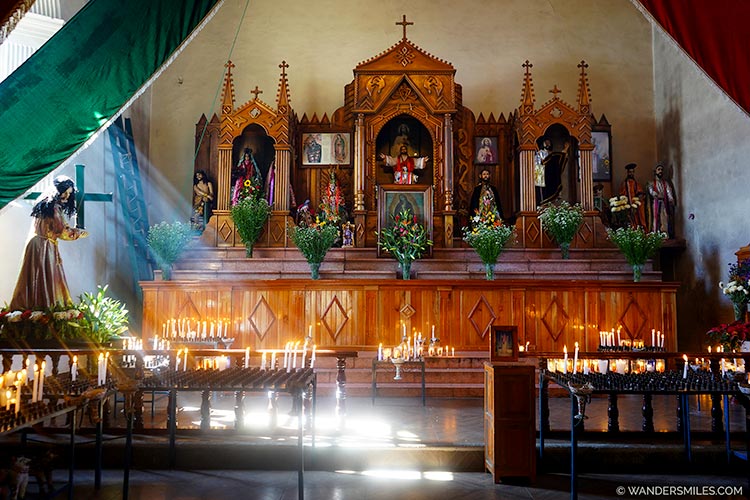Visiting San Juan Chamula and Zinacantán in Chiapas, Mexico
LAST UPDATED: 25th May 2025
If you are looking for an unparalleled experience in Mexico, visiting San Juan Chamula and Zinacantán will leave you lost for words. When I mention the mysterious healing rituals, fizzy drinks, and chicken sacrifices you may understand why!
The religious syncretism of the Tzotzil people has created a unique fusion of their pre-Hispanic Mayan belief system and Catholicism. Indigenous ancestors of Chiapas resisted the indoctrination by missionaries in the Spanish colonisation of the 1520s hence this blend of faith was born.
If you take any day trip from San Cristobal de las Casas, visiting San Juan Chamula and Zinacantán should be top of your list.

Need To Know Before Visiting San Juan Chamula & Zinacantán
Where Is San Juan Chamula & Zinacantán
San Juan Chamula and the neighbouring town, Zinacantán, are located in the Mexican state of Chiapas around 10 km west of San Cristóbal de las Casas. Chamula is located in the Chiapas highlands, at an altitude of 2,200 metres (7,200 feet).
How To Visit Chamula & Zinacantán From San Cristobal
As San Juan Chamula and Zinacantán are unique places to visit with a wealth of fascinating history and culture, I wanted to take an English-speaking tour to indulge my thirst for knowledge. The group numbers were kept to a minimum and our local guide knew his stuff.
|| BOOK SAN JUAN CHAMULA & ZINACANTÁN TOUR <<
Alternatively, you can go independently by taxi or local colectivo (small local bus), and get local guides outside the San Juan Church. Do bear in mind that they will generally be Spanish-speaking only.
Both taxi and colectivo will drop you in the main square (Plaza de la Paz) by San Juan Chamula. If you wish to visit Zinacantán too, you will need to travel by taxi as no colectivos are going there from San Juan Chamula.
- BY TAXI: Uber does not operate in San Cristóbal de las Casas so you’d need to take a local taxi costing around $100-120 MXN pesos.
- BY BUS: The colectivo will pick you up in Calle Honduras and will cost $18 pesos. It will take a little longer as it stops along the way to pick up and drop off.
The Culture Of San Juan Chamula & Zinacantán
The towns are independent, private communities. They are controlled autonomously and make their own rules.
They have their own policing. You can find yourselves in SERIOUS hot water with the natives should you not abide by the local laws, even the Mexican government could not intervene to help
The towns have their own customs. To keep their traditions alive they reject outsiders and change. Autonomy allows them to do this, as well as marriage only being permitted within your community.
Chiapas’ indigenous people live within distinct communities. Each of these has its own language, traditions, costumes, belief systems & patron saints, spiritual healers, and rituals. The largest indigenous group in Chiapas is the Tzotzil people.
The Dress Code In San Juan Chamula & Zinacantán
The Tzotzil people dress traditionally all year round, it’s not just for tourists.
The ladies wear black shaggy wool skirts. The shape is a simple rectangle sewn into a cylinder shape and held up by a belt. The highlands of Chiapas can drop to freezing point and this clumsy-looking fabric is both warm and waterproof.
The length of the woolly skirt signifies your standing in the community. The longer the skirt, the higher the status. For the ladies with a less shaggy appearance, this would signify a much lower class. Less wool means you would own fewer sheep.
The Tzotzil men wear similar furry garments but are worn as wool tunics instead. The traditional way is worn with a leather belt over smart western-style shirts and pants, paired with a cowboy hat to complete the look.
Visiting San Juan Chamula
San Juan Chamula is the principal town of the Tzotzil people and is the main religious and economic centre of the community. About 77,000 Chamulans inhabit the town and predominantly speak the Tzotzil language.
Ritual Sacrifices In Iglesia De San Juan
Firstly, it is not allowed to film or take photos in their San Juan Chamula church. Tzotzil people believe that photographs steal the soul so take this warning seriously. Plain-clothed police may monitor this in the church, which could also be community vigilantes willing to take action.
I heard many horror stories of reprimands such as beatings, smashed cameras, or a stint in an indigenous jail. So you’ll need to use your imagination on this one based on my experience!
NOTE: Sunglasses and hats of any kind are not permitted either. Remember to turn off your phones too.

The festivities for San Sebastian had started. As I stood in front of San Juan Chamula Church to admire the simple decorations of bunting, it became clear that some of the men had been celebrating early doors for the Fiesta de San Sebastian. Their attempts to talk were strained as they swigged on a bottle of Pox (pronounced ‘Posh’), a local liquor, and danced, or stumbled, to the traditional music in the background.
Pox (pronounced posh ) is a distillate of Mayan origin that is traditionally drunk during religious ceremonies. This practice continues now as Maya healers claim pox can cure various ailments, especially when combined with garlic and honey. Pox is prepared from corn, wheat bran, and panela (sugar cane) and is very popular as a greeting, or simply consumed for celebration.
Now, it was time to enter Iglesia San Juan Chamula. I was immediately faced with a mass of colourful flowers, bells, burning candles, and leaves of the pine trees on the floor (an important part of Chamula culture). The walls were lined with framed boxes of statues of saints adorned with mirrors to ward off evil. The tables down each side were covered in flickering candles and more elaborate floral arrangements.
People were entering the church in groups carrying boxes, candles, and bags of fizzy drinks. They will bring candles in different colours depending on the particular request they would like to make to the saint – each colour has a specific meaning. One man entered carrying a beer which did not raise any looks of disdain from fellow worshippers.
Inside the church, it felt chaotic. Everything about it was a far cry from anything Catholic as we know it including the lack of pews, priests, and masses. Family groups claimed their spot on the floor to sit for their ceremonies. There was no organisation, it was just where they could find a spare space. They cleared the pine needles with their hands, scraped away the wax, and proceeded to melt their candles on the tiled floor. I tried to keep out of people’s way as they prayed out loud and ensured I did not come between the worshipper and the specific god they were communicating with.
It was dim inside but the candles lit up the room. The aromatic smell of the smoke of the copal incense and fresh pine needles were radiating through the air. I was captivated by these intriguing rituals but still trying to focus to be wary of the candles haphazardly burning on the floor.
I stumbled upon the start of a ritual healing. The ‘curandero’ (healer) was hypnotically chanting to the worshipper in their ancestral language whilst moving her arms around her head. Once she had neared the end of her ceremony, the box was opened and the chicken was removed to be sacrificed. I took in a gulp of air as they wrung their neck and waved the dead chicken over the worshipper.
To finish the ceremony, they drink fizzy soda. The chicken is not eaten as it is believed to be carrying bad spirits. It is taken home to be chopped into 13 pieces, and the head is buried as a gift for the God of the underworld.
So why is Coca-Cola or other fizzy drinks used in rituals? It is believed that the burps produced by the soda help to purify the soul. Coca-Cola is more so as it is thought to have curative properties. Mexico uses sugar cane in the drink which is more addictive.
Coca-Cola uses the local water to make their drink making water in short supply – it takes 2.5 litres of water for every litre of Coca-Cola. As it is now cheaper than water, and, it is often referred to as “agua negra” (black water) locally. Coupled with the lack of education and big brand marketing, there is a huge Diabetes problem. Shame on you Coca-Cola!
These ritual healings and sacrifices are happening 24 hours a day, seven days a week. This is an authentic experience that you can only believe when you see it with your own eyes. I felt honoured and moved to tears to be allowed to watch these sacred rituals and get a first-hand encounter with their fascinating Tzotzil Maya culture.
San Juan Chamula Market
Around the plaza crowded around the San Juan Chamula Church perimeter, the market stalls sell local foods, crafts, and textiles from under their brightly-coloured umbrellas. Bring plenty of small change or notes ready to shop.
You will notice that the fruit and vegetables are piled up into pyramids or stacks ready to buy. Cowboy hats and piles of wool lay on rugs, and branches of pine leaves are sold for people to adorn their houses or to take into the church.
It’s a hectic but vibrant atmosphere, and not unusual to be asked for money in all the madness.

Ruined Templo De San Sebastian
Not far from San Juan Chamula church are the ruins of the Church of San Sebastian (Templo San Sebastian), which was originally constructed by the Dominicans in the baroque style in the 17th century.
The church has a mysterious backstory. It is thought that the Church was destroyed either during the Revolution (1910-1921), the Cristero War (1926-1929), or possibly just an accidental fire. Either way, the local parishioners demonstrated their unhappiness that the Saints of the Church allowed it to be destroyed by leaving it in ruins and taking the statues of the saints to Iglesia de San Juan Chamula.
San Sebastian Church is surrounded by a cemetery with different sizes of mounds with simple painted wooden crosses. Traditionally, the black cross was for people who died in old age, white for babies, green for children, and blue for all other graves.

Visiting Zinacantán
Zinacantán, meaning “place of the bats”, is a town in Chiapas where 99% of its population is Tzotzil Maya, an indigenous people with linguistic and cultural ties to other highland Maya peoples.
Historically, the Zinacantecos were almost all agriculturists, growing crops of maize, beans, and squashes. However, an increasing number have gone into a variety of alternative enterprises, such as paid work in construction, driving trucks and buses, and cultivating flowers and fruit for urban markets. The presence of the flower industry is evident as there is a mass of greenhouses in the surrounding area.
There is a Tourist Tax for foreigners entering Zinacantán of MXN15 per person.


Buy Artisan Textiles In Zinacantán
Zinacantán is famous for being an artisan town known for its vibrant floral embroidery and backstrap loom weaving. Visit the women’s weaving co-operative where you can see the meticulous crafts on pre-Columbian waist looms, as well as peruse the showroom jam-packed with blouses, huipiles (ponchos), tablecloths, quilts, bags, and more.
The ladies are charming and will adorn you in traditional dress to entice you. Expect a round of tortillas made on the traditional iron plate and pox (pronounced ‘posh’), a regional liquor made from fermented corn, to give you a glow, or maybe help you lose control of your purse strings. I was more than happy to contribute to the co-operative especially when you hear how long it takes to produce one of those lengths of fabric.

Useful Links For Your San Juan Chamula Trip
Ready to get planning and check these links for visiting San Juan Chamula and Zinacantán.
Tours + Transport For San Juan Chamula
- Explore day trips and tours with Viator and Get Your Guide
- Colectivo pick-up point on Calle Honduras
- Explore what to do and where to eat with Tripadvisor
- Not booked your flights yet? Find deals with Skyscanner
Travel Insurance For Mexico
Get 5% off your travel insurance with HeyMondo. Benefit from 24-hour medical assistance, 365 days a year with single, multi-trip, and long-stay insurance, cover for Covid-19, and non-refundable expenses. The handy app makes this a simple process! They give a little back too by contributing to ‘Doctors Without Borders’.
SafetyWing for Digital Nomads. Benefit from 24/7 assistance, comprehensive and medical cover including Covid-19. Buy insurance whilst you are travelling, with the option of global health insurance.
Recommended Gear For Mexico
- GET 15% OFF WATER-TO-GO Bottle (Code WM15)
- GET 10% OFF ARTFULLY WILD sustainable clothing (Code: WM10)
PIN FOR YOUR SAN JUAN CHAMULA TRIP
Disclosure: This post contains affiliate links, which means I may receive a small commission if you click a link and purchase something that I’ve recommended. It comes at no cost to you. Thank you for your support.









